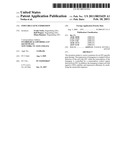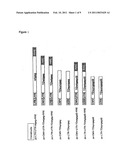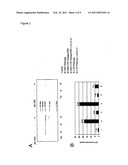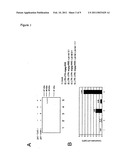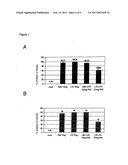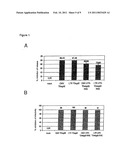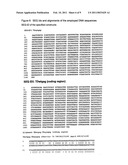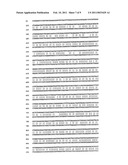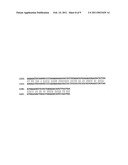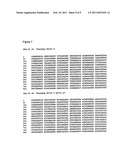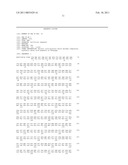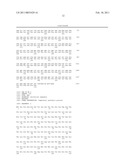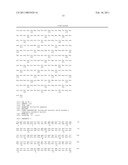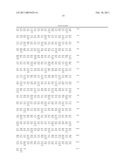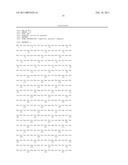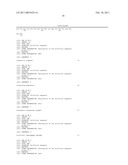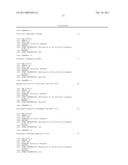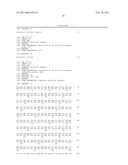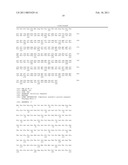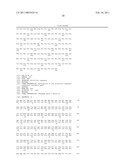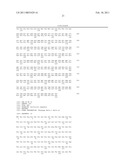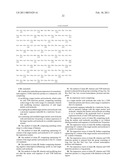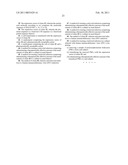Patent application title: Inducible Gene Expression
Inventors:
Frank Notka (Regensburg, DE)
Ralf Wagner (Regensburg, DE)
Diana Hammer (Regensburg, DE)
IPC8 Class: AA61K4800FI
USPC Class:
424 9321
Class name: Whole live micro-organism, cell, or virus containing genetically modified micro-organism, cell, or virus (e.g., transformed, fused, hybrid, etc.) eukaryotic cell
Publication date: 2011-02-10
Patent application number: 20110033429
Claims:
1-24. (canceled)
25. A method for inducible gene expression of a transdominant-negative (TDN) lentivirus protein in a eukaryotic cell, comprising:(i) modifying a target nucleic acid molecule, which codes for said TDN lentivirus protein, comprising matching codon usage to the codon usage of a mammal, wherein said modifying increases expression of said target nucleic acid molecule,(ii) coupling the modified target nucleic acid molecule with a promoter sequence inducible by a lentivirus Tat protein, and(iii) contacting said modified target nucleic acid molecule with said lentivirus Tat protein, to induce expression of the target nucleic acid molecule in a suitable expression system.
26. The method of claim 25, comprising matching codon usage to codon usage of humans.
27. The method of claim 25, comprising optimizing GC content of the target nucleic acid molecule to GC content of the expression system.
28. The method of claim 27, comprising optimizing GC content of the target nucleic acid molecule to the GC content of a mammal.
29. The method of claim 25, further comprising eliminating negative transcription-influencing motifs in said target nucleic acid molecule.
30. The method of claim 25, wherein said modifying does not alter the amino acid sequence of said TDN lentivirus protein.
31. The method of claim 25, wherein said TDN lentivirus protein is selected from the group consisting of Gag, Env, Tat, Rev, Nef, Vpr, Vpv, reverse transcriptase, protease and integrase.
32. An expression vector comprising:(a) a target nucleic acid molecule that codes for a TDN lentivirus protein and whose codon usage is matched to that of a mammal,(b) a promoter sequence inducible by a lentivirus Tat protein in operative linkage with the target nucleic acid molecule, wherein the nucleic acid molecule according to (a) is modified at the nucleotide level to increase expression levels of said TDN lentivirus protein.
33. The expression vector of claim 32, comprising modifying the nucleic acid molecule according to (a) without altering an amino acid sequence of said lentivirus Tat protein.
34. The expression vector of claim 32, further comprising optimizing GC content of the target nucleic acid molecule to GC content of a mammal.
35. The expression vector of claim 32, further comprising optimizing GC content of the target nucleic acid molecule to GC content of humans.
36. The expression vector of claim 32, wherein said TDN lentivirus protein is selected from the group consisting of Gag, Env, Tat, Rev Nef, Vpv, Vpu, reverser transcriptase, protease and integrase.
37. The expression vector of claim 36, wherein said TDN lentivirus protein is a Gag protein.
38. The expression vector of claim 37, wherein said TDN lentivirus protein is a Gag protein with deletions in the p24 region.
39. The expression vector of claim 32, wherein the nucleic acid molecule according to (a) comprises the nucleotide sequence of SEQ ID NO: 1, 16, 17 or 18.
40. The expression vector of claim 32, wherein the promoter sequence is a lentiviral LTR sequence or a functional partial sequence thereof.
41. A cell transformed or transfected with the expression vector of claim 32.
42. A medicament comprising the expression vector of claim 32 and a pharmaceutically acceptable carrier.
43. A medicament comprising the cell of claim 41 and a pharmaceutically acceptable carrier.
44. A method for treating a retroviral infection comprising administering a therapeutically effective amount of the medicament of claim 42 to a subject in need thereof.
45. A method for treating a lentiviral infection comprising administering a therapeutically effective amount of the medicament of claim 42 to a subject in need thereof.
46. The method of claim 44, wherein said retroviral infection is a human immunodeficiency virus (HIV) infection.
47. A method for treating a retroviral infection comprising administering a therapeutically effective amount of the medicament of claim 43 to a subject in need thereof.
48. A method for treating a lentiviral infection comprising administering a therapeutically effective amount of the medicament of claim 43 to a subject in need thereof.
49. The method of claim 47, wherein said retroviral infection is a human immunodeficiency virus (HIV) infection.
50. A method for treating a lentiviral infection in a subject infected with human immunodeficiency virus (HIV) comprising:(i) removing a sample of polymorphonuclear leukocytes (PMLs) from said subject;(ii) transducing the removed PMLs with the expression vector of claim 32; and(iii) administering a therapeutically effective amount of the transduced PMLs to said subject.
Description:
[0001]The present invention relates to a method for inducible gene
expression, in which a target nucleic acid sequence to be expressed is
modified at the nucleic acid level so that an increase in the expression
is achieved, and the nucleic acid sequence modified in this way is
expressed under the control of an inducible transcription control
sequence.
[0002]Many types of viruses are involved in an active export of their incompletely spliced transcripts from the cell nucleus of the infected host cell. This can take place either via the use of a cis-position RNA signal within the viral transcripts (constitutive transport elements) or occurs with the help of viral proteins.
[0003]Cis-active transport elements are used for example from MPMV-CTE (Mason-Pfizer Monkey Virus constitutive transport element), SRV-CTE (Simian Retrovirus constitutive transport element), Hepatitis B-Virus PRE (posttranscriptional regulatory element) and HSV (Herpes Simplex Virus) (within the TK (thymidine kinase) gene). These RNA elements recruit cellular factors and export pathways in order to allow the nuclear export of the viral transcripts.
[0004]As an alternative, the nuclear export can also be mediated via an export factor that binds specifically to a target sequence within the viral transcripts and transports these in co-operation with cellular factors into the cytoplasm. Thus, for example, Ad-5 (Adenovirus 5) transcripts are exported with the aid of the 34K and E4orf6 proteins, EBV (Epstein-Barr Virus) transcripts with the aid of the EB2 protein, Herpes virus Saimiri transcripts with the aid of the ORF 57 gene product, HSV transcripts with the aid of the ICP 27 protein, HTLV-I and II (human T-cell Leukemia Virus I and II) transcripts with the aid of the Rex proteins, EIAV (Equine Infectious Anaemia Virus), SIV (Simian Immunodeficiency Virus) and HIV-1 and HIV-2 (Human Immunodeficiency Virus 1 and 2) transcripts with the aid of the Rev proteins.
[0005]The HIV-1 Rev-mediated nuclear export of subsequent HIV-1 transcripts has been investigated best. Like all Lentiviruses, HIV-1 is involved in activating several genes from only one proviral matrix and expressing them in a time-specified sequence. By alternative splicing events as well as further regulation mechanisms occurring at the RNA level, different genes are generated from only one ˜9 kb long primary transcript. These viral transcripts may be subdivided into three classes according to their size, namely ˜9 kb unspliced (gag, pol), ˜4 kb singly spliced (env, vif, vpr, vpu) and ˜2 kb multiply spliced (rev, tat, nef) RNAs.
[0006]Apart from the occurrence of incompletely to multiply spliced transcripts, a time sequence in the expression of these different RNA species may also be observed. Thus, in the early phase of the replication in the cytoplasm of the infected cells, only the multiply spliced ˜2 kb RNAs and their gene products Rev, Tat and Nef can be detected. Only after a time delay are the unspliced (˜9 kb) and singly spliced (˜4 kb) transcripts and their gene products Gag, Pol and Env then also observed.
[0007]In cells that have been infected with virus mutants lacking an active Rev protein, the singly spliced and unspliced transcripts can be detected, but never in the cytoplasm. The unpsliced and singly spliced transcripts then accumulate in the nucleus and the subsequent structure proteins (Gag, Env) and enzymes (Pol) translated from them cannot be formed. The viral Rev protein is thus involved in an essential way in the time-regulated expression of the viral genes.
[0008]HIV-1 Rev, like the RNA transport molecules listed above, are shuttle proteins which transport viral RNAs from the nucleus to the cytoplasm via the interaction with an RNA target sequence located within viral transcripts. Thus, HIV-1 Rev binds in the nucleus specifically to its RNA target structure RRE, the "Rev-responsive-element". This 351nucleotide (nt) long region is localised within the Env reading frame and is thus a constituent of all unspliced and singly spliced transcripts. This ribonucleoprotein (RNP) complex is then exported from the cell nucleus via interaction with cellular factors. For this purpose a C-terminally located leucine-rich sequence is necessary, which as a nuclear export sequence NES mediates the nuclear translocation of the Rev protein using cellular mechanisms (Pollard et al., 1998).
[0009]The reason why the late transcripts in the absence of Rev remain behind in the nucleus, which is a necessary precondition for the Rev dependence and thus the time-regulated expression of gag, pol and env, is still disputed. In principle there are two main alternative ideas about nuclear retention of late transcripts.
[0010]It is assumed that a cellular transcript can leave the cell nucleus only once the splicing process has been completed, and all active splicing sites have been removed from the primary transcript. Late viral transcripts are intron-containing, only incompletely spliced pre-mRNAs, which are transported to the cytoplasm with the aid of Rev and RRE. For this reason the influence of the cellular splicing machinery on the nuclear retention of the late transcripts was investigated early on (Mikaelian et al., 1996) (Kjems et al., 1991; Kjems et al., 1993; Chang et al., 1989; Powell et al., 1997; Lu et al., 1990; O'Reilly et al., 1995). Due to the presence of variously active splicing sites, the splicing process in HIV-1 transcripts appears to take place only sub-optimally. It has therefore been suggested by several groups of researchers that Rev permits the export of transcripts which can be retained within the splicing machinery due to the formation of inefficient splicing complexes.
[0011]On the other hand it has however been shown that the late HIV-1 genes, such as for example env, remain repressed in their expression also in the absence of active splicing sites, and therefore the influence of the splicing machinery appears to be more indirect (Nasioulas et al., 1994). For this reason so-called inhibitory sequences (INS) or cis-active repressor elements (CRS) within the reading frame have been postulated, which negatively influence the expression (Nasioulas et al., 1994; Olsen et al., 1992; Schwartz et al., 1992b; Maldarelli et al., 1991). These repressor sequences located within the coding mRNA do not however possess any common sequence motif, such as for example the AUUUA instability motif within the 3'-UTR of the unstable GM-CSF mRNA (Chen et al., 1995), but are notable only for their always high A/U content. Thus, the fusion of the postulated INS-containing fragments from reading frames of later genes (such as gag and env) to a CAT-reporter system resulted in a reduced reporter activity (Cochrane et al., 1991; Rosen et al., 1988). This reduction of the expression of gag and poi could to some extent be cancelled again by multiple quiet point mutations within the "wobble" positions (Schwartz et al., 1992a, Schneider et al., 1997). The unspliced and singly spliced HIV-1 mRNAs thus appear to contain cis-active repressor elements, which are removed either by multiple splicing or are overcome by an Rev/RRE-mediated nuclear export.
[0012]An elegant method of circumventing the Rev dependence of HIV transcripts has been developed by Schwartz and Schneider, as already mentioned, in the form of a partial change of the reading frame of HIV genes. A consequent development of this concept led to the synthesis of a codon-optimised HIV-gag-pol gene using synthetic oligonucleotides (Wagner et al., 2000; Graf et al., 2000). This type of matching of the G/C content and codon usage to that of mammalian cells permitted a constitutive synthesis of the Gag-Pol polyprotein in mammalian cells in large amounts. The basic mechanism of this decoupling of the protein synthesis from the Rev dependence is an altered nuclear export of the mRNA. Whereas the HIV wild-type RNA is involved in an alternative export pathway characterised by the Crm1 protein, depending on the HIV shuttle protein Rev, the synthetic mRNA on the regular nuclear export pathway for cellular mRNAs is transported constitutively into the cytoplasm. This constitutive expression of HIV proteins opens up new ways for an HIV treatment at the genetic level.
[0013]The publication by Graf et al. (2000) does not however disclose methods for a gene expression inducible with the aid of a transactive factor.
[0014]Just like the aforementioned publication by Graf et al., DE 1 053 781 A1 too is concerned with the RNA export from the cell nucleus into the cytoplasm. This patent application thus relates to making reporter genes dependent on Rev in order to be able to control the expression of the reporter gene via the nuclear export.
[0015]Since a Rev dependence and RRE dependence impose certain restrictions on the development of HIV-based vectors, Kotsopoulou et al. (2000) synthesised a codon-optimised HIV-1-gag-pol gene. This gene was introduced into a mammalian expression vector and investigated as regards the dependence on Rev. The authors did not however use any promoters inducible with the aid of transactive factors. A method according to the invention is accordingly not disclosed.
[0016]The expression of anti-HIV genes in cells can be efficiently used for an intracellular inhibition of HIV replication (Bunnell et al., 1998). In the meantime a whole range of HIV gene therapy strategies have been developed, ranging from antisense constructs and RNA decoys via specific RNA-decomposing ribozymes and RNA interference to transdominant-negative proteins derived from HIV. Apart from these intracellular inhibitors, which interfere in a targeted manner in steps in HIV replication, within the scope of a gene therapy the re-infection of cells or the propagation of descendant viruses can also be prevented. Various approaches are concerned with the expression of secretable anti-HIV proteins, immunostimulating or non-specific antiviral factors and, not least, with the expression of cell-toxic factors following infection (for overview see Mautino et al., 2002).
[0017]Apart from these rather non-specific inhibitory strategies, virus multiplication can take place by preventing virus release in a very specific manner, using HIV-own protein derivatives. Deletions in Gag mediate a transdominant-negative (TDN) effect to the new formation and release of descendant viruses (von Poblotzki et al., Trono et al., 1989; Smythe et al., 1994: Furuta et al., 1997). These deletions are in p17MA, in the transition region of p17MA/p24CA and in the C-terminal domain of p24CA. The exact action mechanism of the transdominant-negative effect has not been clarified. Some clues point however to an influence of the reduced cyclophilin A binding capacity of the mutated p24CA (Chiu et al., 2002) and to an altered membrane targeting, from the plasma membrane to the ER membrane, with deletions in p17MA (Facke et al., 1993; Gallina et al., 1994; Ono et al., 2004). Since Gag is a very strongly multimerising polyprotein and an exact clustering is necessary for the correct formation of HIV particles (Wilk et al., 2001), it is obvious that TDN Gag deletion derivatives with functional assembly domains (C-terminal domains of p24CA) directly interfere, by a binding to wild-type Gag proteins, with the assembly of HIV capsids and thus demonstrably lead to an inhibition of HIV replication.
[0018]Particularly the last strategy however exhibits some problems in a constitutive protein expression. Thus, the expression of the foreign gene can lead to cell toxicity, a faulty regulation of cellular functions, a reduced regulation of the transcription and, specifically in the case of a protein derived from HIV, to an undesirable immune response (Smythe et al., 1994). In order to circumvent these problems, various strategies are adopted to make the expression of the transgene dependent on an HIV infection.
[0019]In various approaches a Tat-, a Rev- and a Tat/Rev-dependent expression have been investigated and in some cases the inhibition of HIV replication in vitro has been described (Caruso et al., 1992; Harrison et al., 1992; Liu et al., 1994). In agreement with this, the expression of thymidine kinase (Marcello et al., 1998) and interferon α2 (Ragheb et al., 1999) could be raised by Tat by a factor of 5 and 4 respectively, and by Rev by a factor of 3.3 and <2 respectively. The combined addition of Tat and Rev led however to very different results: the expression of thymidine kinase was raised by a factor of 7, whereas for interferon α2 an increase in expression by a factor of >300 was reported. For HIV-1 TDN Gag derivatives a clear Rev-mediated induction of protein synthesis (with low basal activity) could be shown, which was associated with a broad inhibition of HIV replication (up to 94%) (Smythe et al., 1994; Furuta et al., 1997). For the combination of Tat-dependent and Rev-dependent expression of TDN Gag, a sharply increased protein synthesis was achieved by co-transfection of tat-expression and rev-expression plasmids (Ding et al., 2002; Cara et al., 1998). Here it was found however that the inhibition of the HIV replication was only partial (Cara et al., 1998) and reached a high level only by combination with various inhibitory strategies (Ding et al., 2002; Cara et al., 1998). In contrast to this the LTR/Tat-inducible expression of suicide genes such as TK led, in many cases to an inhibition of virus replication (Marcello et al., 1998; Miyaka et al., 2001; Ragheb et al., 1999).
[0020]As regards the basal activity, it has been correspondingly shown that a dependence on Rev does not lead to an absolute prevention of protein synthesis. Rev influences the export of RNA from the cell nucleus and is functional only in combination with corresponding cis-active retention sequences (INS, see above) and a cis-located recognition sequence (RRE). Gag genes isolated and reduced in size (and therefore also in the size of the INS) are efficiently transcribed under a correspondingly active promoter (e.g. CMV), and it is clear that a certain part of the RNA reaches the cytoplasm and is translated without the support of Rev.
[0021]There is no unambiguous data regarding the regulation by LTR/Tat. Most reports have described a basal activity of the genes under LTR control (Caruso et al., 1992; Ding et al., 2002; Muratori et al., 2002; Cara et al., 1998). Possible explanations of this expression in the absence of Tat are an activation of the LTR promoter by TNFα, which was secreted from the corresponding transduced cells (Muratori et al., 2002), or elements of the vector construct, which are derived from HIV (Miyake et al., 2001).
[0022]Also, the length of the LTR that is used may have an influence on the regulation. Thus, a complete switching off of the transcription in the absence of Tat was detected with a minimal LTR (Miyake et al., 2001), i.e. a "tight" inducible promoter was described.
[0023]For an HIV-dependent transgene expression the LTR/Tat system therefore appears to be the more important switch module; and this also for the reason that an induction by Rev is downstream of that by Tat, which can lead to an initial virus multiplication, and specifically shortly before the inhibition by the transgene can act. Thus, among other things the observed incomplete inhibition of the replication after Rev induction is explained (Smythe et al., 1994).
[0024]However, for a Tat-inducible expression of transdominant-negative (TDN) Gag derivatives, in contrast to suicide genes up to now a sufficient inhibition of the HIV replication has still not been detected (see above). There are several possible explanations for this:
i) The TDN action correlates with the amount of the TDN protein, i.e. a certain limit must be exceeded in order to achieve an effective intervention. The amount of protein depends however to a large extent on the promoter activity. Compared to highly active viral promoters (e.g. CMV SV40) this is relatively slight in HIV-1 LTR, and is therefore possibly not sufficient.ii) The TDN derivatives used hitherto are derived from the HIV-1 wild-type genome, and consequently contain INS motifs and are therefore dependent on a Rev-mediated nuclear export. As described above, the actual inhibitory action starts only with the presence of REV in the cell nucleus, whereby the first HIV transcripts pass unhindered into the cytoplasm and can complete the replication. It is therefore not surprising that a combination of both regulation systems leads to a very inefficient inhibition of HIV replication (Cara et al., 1998).
[0025]Apart from the LTR-tat system, many other inducible viral promoters are known. Also, other inducible expression systems are known in the prior art. Often however the desired degree of gene expression cannot be achieved with an inducible system. An object of the present invention is accordingly to provide a method for inducible gene expression.
[0026]This object is achieved by a method for inducible gene expression, comprising [0027](i) provision of a target nucleic acid sequence to be expressed, [0028](ii) modification of the target nucleic acid sequence to be expressed so that an increase in the expression is achieved, [0029](iii) operative coupling of the modified target nucleic acid sequence with an inducible transcription control sequence, [0030](iv) expression of the modified target nucleic acid sequence in a suitable expression system by a transactive factor.
[0031]It has surprisingly been found that the inducible expression of a coded gene in a target nucleic acid sequence to be expressed (hereinafter also termed transgene) can be significantly improved if on the one hand its sequence at the nucleic acid level is modified to achieve an increase in gene expression, and on the other hand the target nucleic acid is expressed under the control of a transcription control sequence inducible by a transactive factor.
[0032]An inducible gene expression is essential for example when toxic gene products are used, and with other, therapeutically usable genes has decisive advantages compared to a constitutive expression: [0033]A non-infected cell is in its physiological performance not subjected to stress due to a high expression of additional factors. [0034]Non-specific or non-foreseeable interactions of the gene products could lead to physiological modifications such as activation, proliferation or the like, also in neighbouring cells, in tissues or in the whole organism. [0035]Proteins derived from HIV are recognised by immune cells in the environment of an HIV infection and the corresponding protein-expressing cells are eliminated. [0036]In the case of toxic factors a constitutive production must be avoided.
[0037]A transcription control sequence is a nucleic acid sequence which permits the expression of a nucleic acid sequence, in particular of a gene, operatively associated therewith. It may in this connection be a promoter, and in addition the transcription control sequence may also include further elements such as for example enhancers and the like. Preferably the inducible transcription control sequence is an inducible promoter. In this connection in principle every inducible promoter system that is known in the prior art is suitable. A natural or artificial inducible promoter, for example a promoter inducible by tetracyclin (Tet on/Tet off system), may for example be used. Furthermore, an inducible viral promoter may however also be used.
[0038]The transcription control sequence is induced by a transactive factor. The transactive factor is a factor that acts in trans and has an influence on the transcription. The transactive factor is preferably a transcription factor. Particularly preferably the transactive factor is a viral transactive factor.
[0039]Preferably the inducible transcription control sequence can be induced by a viral transactive factor. A viral inducible transcription control sequence that can be induced by a viral transactive factor may be derived from an arbitrary virus. Sequences of retroviruses, HCV (Hepatitis C Virus), HBV (Hepatitis B Virus), HSV (Herpes Simplex Virus), EBV (Epstein-Barr Virus), SV40 (Simian Virus 40), AAV (Adeno-associated Virus), Adenovirus, Papilloma Viruses or Ebola Virus are preferably used for this purpose. The transactive factors used in this connection are accordingly selected for example from the following viral factors, but are not restricted to these: NS5A (HCV), HB X (HBV), VP16/ICP4 (EBV), EBNA1/Rta (EBV), ART (HHV8), Large T-Antigen (SV40), Rep78/68 (AAV), E1A (Adenovirus), E2 (Papilloma Virus) and VP30 (Ebola Virus).
[0040]A retroviral LTR promoter or a functional partial sequence thereof is preferably used as inducible transcription control sequence that can be induced by a viral transactive factor. Preferably therefore the transactive factor is a retroviral Tat or Tax protein. The LTR promoter may be selected from LTRs of HIV-1, HIV-2, SIV, HTLV and other related retroviruses that contain LTR promoters. In particular lentiviral promoters are preferred, especially those of HIV.
[0041]A transactive factor within the meaning of the present invention is thus a factor which exerts in trans an influence on the transcription, preferably due to the fact that the transactive factor interacts with the inducible transcription control sequence. An example of such a transactive factor is thus the Tat protein already mentioned above.
[0042]In order to improve the gene expression the target nucleic acid sequence to be expressed is modified. This occurs at the nucleic acid level and preferably in such a way that the corresponding amino acid sequence is not, or is not substantially, altered. If the amino acid sequence is altered in the modification of the nucleic acid sequence in order to raise the gene expression, then this should have no influence on the function of the resulting protein.
[0043]The modification of the target nucleic acid sequence to raise the gene expression may be carried out in several ways.
[0044]On the one hand it is possible to match the codon usage of the transgene to the employed expression system. A eukaryotic expression system, in particular a mammalian-based one, is preferred, especially in this connection one based on mammalian cells, preferably human cells. The codon usage of the transgene is therefore preferably matched to the codon usage of mammalian cells, more preferably to that of human cells.
[0045]Modified target nucleic acid sequences according to the invention and preferably suitable for gene therapy can be created for example by choosing the codon distribution as it occurs in exported cellular mRNA. Preferably in this connection a codon choice should be used such as is most frequently or next most frequently employed in mammalian cells (Ausubel et al., 1994), and even more preferably the codon choice is matched to that of actively expressed mammalian genes. Preferably the nucleic acid sequence is modified for an optimal expression in mammals using the gene optimiser technology (German Patent Application DE 102 60 805.9, PCT/EP03/14850).
[0046]Instead of or also in addition to the matching of the codon choice, it is however also possible to optimise the GC content. This is preferably achieved by matching the GC content of the transgene as accurately as possible to the GC content of the expression system that is used. In this connection the degeneracy of the genetic code is preferably utilised, so that the alteration of the nucleic acid sequence for the purposes of increasing the GC content does not lead to an alteration of the amino acid sequence. The optimal percentage content of G and C nucleotides in a sequence to be expressed depends, as already mentioned, on the respective organism and on the respective cells in which the sequence is to be expressed. For example, the optimal GC content in nucleic acids in mammalian cells is about 50%. Reference documents already exist in which the person skilled in the art can look up the optimal GC content for various organisms and cells. The regularly updated codon usage database exists at www.Kazusa.or.jp/codon/ of Y. Nakamura at the Kazusa DNA Research Institute, see also Nakamura, Y et al., (2000) Nucl. Acids Res. 28, 292. It is therefore no problem for the person skilled in the art to optimise, as regards the GC content, the nucleic acid sequence of the target nucleic acid to be expressed.
[0047]The optimisation of the GC content or the matching of the codon usage is preferably carried out by silent mutations or by mutations that do not influence the activity of the protein coded by the transgene. The codon usage need not necessarily be matched if the GC content of the said gene is already more than 50%. Genes with codon usage differing from the wild type may, as mentioned in the example, be produced from long oligonucleotides by a stepwise polymerase chain reaction (PCR).
[0048]A further possible way of modifying the target nucleic acid sequence to be expressed for the purposes of improving the expression is, either instead of the above possibilities, or in addition to these, to purposefully eliminate motifs that negatively influence the transcription. This includes for example the deletion of nucleic acid motifs such as poly-A sequences and the like, which could well already be known to the person skilled in the art. Further such motifs negatively influencing the expression include RNA instability motifs, adenine-rich motifs, recognition motifs for endonucleases, motifs that influence the RNA secondary structure, and the like.
[0049]The target nucleic acid sequence to be expressed preferably codes for a therapeutic and/or diagnostic protein. Such a protein may be chosen for example from toxic gene products, suicide factors, apoptosis-inducing proteins, messenger substances, transactive factors, regulator proteins, transdominant-negative proteins, cytokines, chemokines, etc. Specific examples are interferon α, SDF-I RANTES, MIP1α, TNF and interleukins, in particular interleukins 2, 6, 10, 12, 15 and 28. Preferably the target nucleic acid sequence to be expressed codes for a gene which, when the LTR/Tat system is used, produces proteins, for example after activation by HIV infection, which are capable of inducing the natural defence mechanisms of adjacent cells or of preventing, by binding to the corresponding receptors, an infection with HIV. In the case of HIV these are in particular the receptors CD4, CCR5 or CXCR4.
[0050]Further examples are enzymes, such as for example thymidine kinase, cytosine deaminase, purine nucleoside phosphorylase, carboxypeptidase, carboxylesterase, nitroreductase, peroxidase, xanthine-guanine phosphoribosyltransferase, glycosidase, thymidine phosphorylase and the like.
[0051]The method for the expression of toxic gene products, e.g. thymidine kinase from herpes viruses, nucleases or apoptosis-inducing proteins (e.g. FAS/FAS ligand, caspases, etc.) is particularly suitable. Apart from caspases, also suitable are TNF-related apoptosis-inducing ligand (TRAIL), protein kinase C (PKC), Tumor necrosis factor (TNF), apoptosis-inducing factor (AIF) and the like. After infection with HIV, the expression of genes would in this case be induced, the cells would be damaged, and thus the new production and propagation of descendant viruses would be prevented.
[0052]Furthermore, the transgene may be a regulator gene which, after its induced expression in a cell, acts as a molecular switch molecule and switches the expression of other genes on or off. A gene that codes for a transcription factor may for example be used as such a regulator gene. Of course, these possible uses are not restricted to infection with HIV, and the person skilled in the art is able to use corresponding systems also for other infections.
[0053]The transgene is preferably a viral gene.
[0054]Moreover, the target nucleic acid sequence to be expressed may also be a gene for a transdominant-negative (TDN) protein. Preferably in this case it is a viral TDN protein, preferably a retroviral TDN protein and most preferably a lentiviral TDN protein.
[0055]In this connection lentiviral TDN proteins are particularly suitable, e.g derivatives of Pr55gag, Gp41, Gp120, Rev, protease, integrase, reverse transcriptase, Nef, Vpr, Vpv or any other lentivirus protein that is able to interrupt the replication cycle of lentiviruses, in particular HIV, or to prevent the release or splitting off of virus particles.
[0056]Preferably HIV-1 gag (group-specific antigen) is used as transgene, in which case its codon choice is adapted to the codon choice as is to be found in human genes.
[0057]Particularly preferably a gag gene is used that contains further deletions. This can further intensify the TDN action. Preferably in this case further deletions in the p24 region or individual or multiple assembly domains are involved.
[0058]For example, the amino acid sequence of the gag gene product was back-translated into a synthetic Gag-coding reading frame using the codon choice of human genes. This reading frame known as "syngag" was then constructed as a completely synthetic reading frame using long oligonucleotides and a stepwise PCR. The syngag reading frame was then cloned into an expression vector. The produced syngag vector appeared in the expression of HIV gag as being completely independent of the presence of the Rev protein, an RRE sequence, a 5' untranslated region (UTR) or splice sites. The output gag gene, which corresponds in its codon choice to the HIV-1 wild-type gene (wtgag), appeared in its expression however as dependent on Rev RRE and the 5'-UTR inclusive splicing donor (Graf et al., 2000).
[0059]Furthermore the invention therefore preferably relates to a method for the expression of transdominant-negative (TDN) lentivirus proteins in eukaryotic cells, comprising: [0060](a) Introducing a vector, comprising a target nucleic acid sequence to be expressed, which codes for a TDN lentivirus protein and whose codon usage is matched to that of mammals, and a promoter sequence inducible by lentivirus Tat protein in operative coupling with the target nucleic acid sequence, in a eukaryotic cell, [0061](b) Provision of the Tat protein so that an expression of the target nucleic acid sequence is induced.
[0062]Surprisingly the LTR/Tat system can be used despite the aforementioned limitation, if, as described above, the expression of the TDN derivative is independent of Rev/RRE. In the present invention this is achieved by matching the codon usage to that of mammalian cells.
[0063]In the combination of LTR and synthetic HIV reading frames an early expression of the TDN gene--in an early phase of HIV infection--is connected with an efficient nuclear export (plus an RNA stabilisation) and thus with a protein biosynthesis, before HIV-own structure proteins and thus target proteins are produced. Overall this combination offers i) a high TDN protein amount combined with ii) a kinetically favourable expression behaviour and iii) a very efficient inducibility.
[0064]As a delimitation with respect to the hitherto described methods, i) the inducibility of the expression is restricted to the presence of Tat, whereby the need for HIV RRE/Rev in the transfer construct is avoided, and ii) the Rev independence of the transcript is guaranteed by a suitable codon choice for the transfer construct.
[0065]The transcription control sequence for the transgene is preferably positioned similarly to the natural occurrence.
[0066]The induction of the promoter is carried out by a lentiviral Tat protein, preferably by the HIV Tat protein, which acts as transactive factor. This allows an induction of the promoter by an infection of the cell containing the vector, to take place with a lentivirus, in particular HIV, by itself. Such an in trans active factor is understood within the meaning of the present application to be an individual protein as well as a protein complex.
[0067]The stabilisation of the RNA and the improvement of the nuclear export properties as well as the independence of the protein production on an RRE/Rev interaction (in the case of HIV-derived proteins) may for example be achieved by a corresponding codon choice, taking into account motifs that influence RNA stability.
[0068]The invention moreover relates to a nucleic acid vector comprising: [0069](a) a target nucleic acid sequence to be expressed, [0070](b) a transcription control sequence inducible by a transactive factor, preferably by a viral transactive factor, in operative combination with the target nucleic acid sequence to be expressed,wherein the sequence according to (a) is modified at the nucleic acid level in such a way that an increase in expression is achieved.
[0071]A nucleic acid vector is understood in this connection to denote a nucleic acid construct that is capable of expressing a target nucleic acid sequence contained thereon in a suitable expression system, e.g. a cell, an organism or in an in vitro system, and which includes at least one target nucleic acid sequence to be expressed and an inducible transcription control sequence in operative combination therewith. Such a vector may contain further coding sequences, such as e.g. selection marker genes and the like. The person skilled in the art is able to use the target nucleic acid sequence to be expressed in combination with its transcription control sequence in a suitable commercially obtainable plasmid vector or the like or also a self-constructed vector.
[0072]The target nucleic acid sequence to be expressed and the inducible transcription control sequence may also be chosen in this case as described above. Also, the modification of the sequence may be carried out as explained above.
[0073]A preferred embodiment relates to vectors which can be used in HIV gene therapy and which are characterised in that they code for a therapeutic gene that is expressed only after infection of the cell by HIV. The transcription of corresponding genes is in this connection controlled by the HIV-own LTR (long terminal repeat) region and takes place in the presence of the HIV-Tat protein. Also, preferably synthetic reading frames adapted to expression in human genes are used for the therapeutic genes, to increase the gene expression, in particular the RNA stability and the RNA nuclear export. These genes may preferably be targeted against different steps in the HIV replication cycle and intervene in the infection of cells, the replication of HIV or the propagation of descendant viruses.
[0074]The vector according to the invention may additionally contain a further transgene, which preferably codes for a therapeutic, gene therapeutic and/or diagnostic protein. This further transgene may likewise be under the control of an LTR promoter, for example the same promoter as the sequence according to (a). However, it may also be controlled by a separate promoter, which may be constitutive or inducible.
[0075]The vector may for example be of viral (e.g. adeno-associated viruses, adenoviruses, retroviruses, herpes viruses, alpha viruses, etc. a) or bacterial origin, or may be a plasmid. Particularly preferably the inducible transcription control sequence is chosen so that the expression of the foreign gene depends on the presence of the HIV-1 Tat protein. If the Tat transactivation is successfully reconstituted, there should preferably be a measurable increase in the expression of the Tat-dependent gene by a factor of at least 3, preferably 5, and still more preferably by a factor of 10 or more.
[0076]The vector preferably contains a sequence according to SEQ ID NO. 1, 16 or 17.
[0077]The present invention furthermore provides modified target nucleic acid sequences which, when operatively coupled with a suitable inducible transcription control sequence, bring about an increased gene expression. Preferably these modified target nucleic acid sequences are selected from the sequences given in the examples of the present invention and specified in the sequence protocol. Most preferred are the modified target nucleic acid sequences selected from the following sequences: SEQ ID NO. 1, 16 and 17.
[0078]The present invention furthermore provides cells, preferably eukaryotic cells, more preferably mammalian cells, most particularly preferably human cells, which have been transformed with a nucleic acid or a vector, as described above, in which the nucleic acid is present in a transcriptable form. The nucleic acid and the vector may for example be present episomally or may be stably integrated into the chromosome. In this case the cell may contain one or more copies.
[0079]The present invention moreover relates to medicaments based on the vectors and modified lentiviruses and cells disclosed here. The medicaments according to the invention are suitable for therapeutic and diagnostic uses, and in particular are suitable for the diagnosis, prevention or treatment of virus-associated diseases and/or tumours. For these applications the target nucleic acid sequence to be expressed may for example in particular be a suicide gene or the like.
[0080]The medicaments may for example be used for treatment purposes, preferably for the treatment of lentiviral infections, e.g. HIV and SIV, in particular HIV-1 and HIV-2. The person skilled in the art is able to match the promoter sequence to the system in which the expression is to take place. Lentiviral infections can now be controlled in this way, by treating infected persons in vitro, ex vivo and of course in vivo, for example by introducing the nucleic acids or vectors according to the invention into PMLs from these patients or into T cells in different stages of differentiation, or into stem cells.
[0081]The invention will be described in more detail hereinafter with the aid of the following figures and examples.
FIGURES AND SEQUENCES
[0082]FIG. 1 shows diagrammatically all produced gag-coding constructs.
[0083]FIG. 2 shows the results of the expression of various gag-coding constructs in H1299 cells.
[0084]FIG. 2A shows an HIV-1 p24-specific western blot of transfected cells.
[0085]FIG. 2B shows a p24 ELISA test.
[0086]FIG. 3 shows the results of the expression of wild-type gag-expressing constructs in the presence and absence of Tat and/or Rev.
[0087]FIG. 3A shows an HIV-1 p24-specific western blot of transfected cells.
[0088]FIG. 3B shows an ELISA test.
[0089]FIG. 4 shows the effect of the transdominant negative gag proteins on the release of HIV particles.
[0090]FIG. 4A shows the inhibition of the release of particles in percent according to a p24 ELISA test.
[0091]FIG. 4B shows the inhibition of the infectivity of the released virus particles in percent.
[0092]FIG. 5 shows the inhibition of the release of virus particles in percent, which were formed in the presence of transdominant negative gag constructs with further deletions in p24.
[0093]FIG. 5A shows the inhibition of the release in percent.
[0094]FIG. 5B shows the inhibition of infectivity in percent.
[0095]FIG. 6 shows the sequences of TDsyngag and TDwtgag as well as a sequence comparison between TDwtgag and TDsyngag.
[0096]FIG. 7 shows the nucleic acid sequences of TDsyngag delta 2 and TDsyngag delta 2 delta p7.
[0097]SEQ ID No. 1 shows the nucleic acid sequence of TDsyngag.
[0098]SEQ ID No. 2 shows the amino acid sequence of TDsyngag.
[0099]SEQ ID No. 3 shows the nucleic acid sequence of TDwtgag.
[0100]SEQ ID No. 4 shows the amino acid sequence of TDwtgag.
[0101]SEQ ID Nos. 5 to 15 show various oligonucleotides.
[0102]SEQ ID No. 16 shows the nucleic acid sequence of TDsyngag delta 2.
[0103]SEQ ID No. 17 shows the amino acid sequence of TDsyngag delta 2.
[0104]SEQ ID No. 18 shows the nucleic acid sequence of TDsyngag delta 2 delta p7.
[0105]SEQ ID No. 19 shows the amino acid sequence of TDsyngag delta 2 delta p7.
EXAMPLES
Example 1
Production of Independent Tat-Dependent, Rev-Dependent and Tat- and Rev-Dependent Gag Gene Derivatives
[0106]HIV-1 transdominant-negative (TDN) gag derivatives were produced as constitutively, Tat-, Rev- or Tat/Rev-dependent expressing gene constructs. The Rev dependence was achieved by using HIV wild-type (wt) gene sequences, including the 5'-untranslated region (UTR), in conjunction with the HIV Rev-responsive element (RRE). The Rev-independence was made possible by synthetic, GC-rich gene sequences, in which the coded amino acid sequence is identical for both constructs. A dependence on Tat was achieved by using HIV-1 LTR as transcription control. On the other hand, the CMV-promoter/enhancer was used for a constitutive transcription. By appropriate combination of the elements a constitutive expression (CMV-syngag), a Tat-dependent (LTR-syngag), a Rev-dependent (CMV-UTR-wtgag-RRE) and a Tat- and Rev-dependent (LTR-UTR-wtgag-RRE) expression of identical (at the protein level) TDN gag derivatives was generated.
[0107]The reading frame of the HIV-1 group-specific antigen (gag) (GenBank Accession Number: M15654.1 HIVBH102, nucleotides 112-1650; Reference: Ratner L, Haseltine W, Patarca R, Livak K J, Starcich B, Josephs S F, Doran E R, Rafalski J A, Whitehorn E A, Baumeister K, et al., Complete nucleotide sequence of the AIDS virus, HTLV-III. Nature. 1985 Jan. 24-30; 313 (6000): 277-84) should be constructed artificially using a codon choice, such as is to be found in human cells. For this purpose the amino acid sequence of the Gag protein (corresponding to GenBank Accession Number: M15654 JIVBH102, nucleotides 112-1408) with a deletion of nt 304-489 was converted into a corresponding nucleotide sequence. A corresponding software package (GeneOptimizer) was used for the codon optimisation and optimisation of the RNA sequence. For the sub-cloning as well as for the attachment of further sequence elements within untranslated regions, further restriction interfaces were inserted. The nucleotide sequence, including the interfaces, is given in SEQ ID NO. 1.
[0108]This sequence was produced as a fully synthetic gene using synthetic oligonucleotides according to an already described method (Zolotukhin et al., 1996).
[0109]A comparison of the nucleic acid sequences of TDsyngag (codon choice derived from mammalian genes) and TDwtgag (codon choice derived from HIV structure genes) is shown in FIG. 6. The TDgag-coding DNA fragment ("TDsyngag") produced in this way was inserted into the expression vector pcDNA3.1(+) (Invitrogen) using the interfaces EcoRI and Xho I, under the transcriptional control of the cytomegalovirus (CMV) early promoter/enhancer ("pc-CMV-TDsyngag").
[0110]To produce a similar expression plasmid, though corresponding in its codon choice to the HIV wild-type, the coding region of HIV-1 gag, including the 5'-untranslated region (UTR), was subcloned and, in order to meet the conditions for a Rev-mediated nuclear export, an RNA target sequence (RRE) was attached to the wtgag-coding region (Graf et al., 2000). This target sequence interacts at the RNA level with a viral nuclear export protein (in the case of HIV-1 the Rev protein) and cellular nuclear export proteins.
[0111]In order to ensure a matching at the protein level, the wild-type construct was C-terminally shorted by introducing two successive stop codons in the gag reading frame (codons for 372F and 373L were mutated). The mutations were introduced by directed mutagenesis (QuickChange site-directed mutagenesis kit, Stratagene) using the oligonucleotides gag-stop1 and gag-stop2. The resulting construct was designated pc-CMV-UTR-wtgag-RRE. Using the oligonucleotides Del1 and Del2, a deletion from nt 304 to nt 489 was introduced into this construct, similarly to the TDsyngag (pc-UTR-TDwtgag-RRE). The coding sequence is given in SEQ ID No. 3.
[0112]The coding sequences were placed under the transcriptional control of the HIV promoter, in order to achieve a Tat dependence of the gag protein derivative. The HIV-1 long terminal repeat (LTR) contains such a promoter. This region was amplified by means of PCR using the oligonucleotides ltr1 and ltr2 from proviral HIV-1 DNA (HX10, see (Ratner et al., 1987)) and cloned using the interfaces MluI and EcoRI directly 5' in front of the ATG of the gag-coding reading frame in pc-CMV-TDsyngag, the CMV promoter having been replaced by the LTR. For the replacement of the promoter in the wt gag construct, parts of the HIV genome were amplified using the oligonucleotides ltr1 and ltr3 in a PCR reaction and replaced using the interfaces MluI and CiaI of the CMR promoter in the pc-CMR-UTR-TDwtgag-RRE construct. At the same time the natural reading frame of the HIV provirus (with the sequence LTR, UTR, gag) was produced again. The resulting constructs have been denoted hereinafter "pc-LTR-TDsyntgag" and "pc-LTR-UTR-TDwtgag-RRE".
[0113]All produced Gag-coding constructs are shown diagrammatically in FIG. 1.
Example 2
The Expression of the TDgag Constructs can be Controlled by HIV Regulator Proteins
[0114]All cell culture products were obtained from Life Technologies (Karlsruhe). All mammalian cell lines were cultured at 37° C. and 5% CO2. The human lung cancer cell line H1299 was cultured in Dulbecco's modified eagle medium (DMEM) with L-glutamine, D-glucose (4.5 mg/ml), sodium pyruvate, 10% inactivated foetal bovine serum, penicillin (100 U/ml) and streptomycin (100 μg/ml). The cells were sub-cultured in a ratio of 1:10 after confluence was achieved.
[0115]1×106 cells were seeded out in Petri dishes (diameter 100 mm) and transfected 24 hours later by calcium phosphate co-precipitation (Graham et al., 1973) with 30 μg TDgag plasmids and 15 μg pc-tat (Tat expression plasmid) or pc-rev (Rev-expression plasmid) or pcDNA 3.1 vector (reference plasmid). With co-transfections of gag, tat and rev, 15 μg of plasmid were used for each one. Cells and culture supernatants were harvested 48 hours after transfection. The transfected cells were washed twice with ice-cold PBS (10 mM Na2HPO4, 1.8 mM KH2PO4, 137 Mm NaCl, 2.7 mM KCl), scraped off in ice-cold PBS, centrifuged for 10 minutes at 300 G and lysed for 30 minutes in lysis buffer on ice (50 mM Tris-HCl, pH 8.0, 0.5% Triton X-100 (w/v)). Insoluble constituents of the cell lysate were centrifuged off for 30 minutes at 10000 G and 4° C. The total amount of protein in the supernatant was measured with the Bio-Rad protein assay (Bio-Rad, Munich) according to the manufacturer's instructions.
[0116]An equal volume of double sample buffer (Laemmli, 1970) was added to the samples and heated for 5 minutes at 95° C. 50 μg of total protein from cell lysates were separated via a 12.5% SDS/polyacrylamide gel (Laemmli, 1970), electrotransferred onto a nitrocellulose membrane and analysed with the monoclonal p24-specific antibody 13-5 (Wolf et al., 1990) and detected by means of a secondary, AP- (alkaline phosphatase) coupled antibody and identified by means of chromogenic colouration (FIG. 2a).
[0117]In addition to this the cell lysates were quantified in a commercially obtainable p24 ELISA test (NEN). 1 μg portions of the cell lysate were evaluated according to the manufacturer's instructions and the total concentration of HIV-1 p24 was determined (FIG. 2B).
[0118]H1299 cells were transiently fixed with the gag constructs. The achieved expression was analysed in the presence and absence of Tat or Rev (FIG. 2). For the pc-CMV-TDsyngag a constitutive expression of TDgag was detected independently of Tat or Rev (FIGS. 2A, trace 2, and 2B, 2). The expression of TDgag could be raised for the pc-CMV-UTR-TDwtgag-RRE construct by Rev by a factor of 7 (FIG. 2A, traces 3 and 4 and 2B, traces 3 and 4), and for the pc-LTR-TDsyngag construct by co-transfection of pc-tat, by a factor of 2.5 (FIG. 2A, traces 5 and 6, and 2B, traces 5 and 6). The basal activity of the Tgag expression was somewhat lower for the pc-LTR-TDsyngag construct compared to pc-CMV-UTR-TDwtgag-RRE, for both constructs however was significantly reduced compared to pc-CMV-TDsyngag, and was only slightly above the negative control (ca. by a factor of 2.5 for pc-CMV-UTR-TDwtgag-RRE and 1.5 for pc-LTR-TDsyngag; FIG. 2B). The gene product of pc-LTR-UTR-TDwtgag-RRE could not be detected by these methods. The deletion in Gag leads to a reduced recognition by the monoclonal antibody, and in combination with a greatly restricted expression the TDgag amounts that are achieved are insufficient for a detection by antibodies. Accordingly, the Tat and Rev dependence was investigated in a reference construct (complete wtgag sequence). This construct (pc-LTR-UTR-wtgag-RRE) was dependent on Tat as well as on Rev. Tat alone led to an increase in expression by a factor of 4, Rev alone led to an increase by a factor of 16, and the combination of Tat and Rev by a factor of 47 (FIG. 3).
Example 3
The TDgag Constructs have a Transdominant Negative Effect on the HIV Particle Release
[0119]H1299 cells were transiently transfected with combinations of plasmids, as described in Example 1. For a transfection, 15 μg of HX10 proviral DNA and 30 μg of the TDgag constructs or 30 μg of pcDNA3.1 were used as control for an uninhibited replication. After 48 hours the cell culture supernatants were harvested, cell constituents were sedimented by centrifugation (10 minutes at 10000 G) and the supernatants were incubated for 15 minutes at RT with 10% of a Triton x 100 solution (5%) to lyse the HIV particles in the supernatant. The treated supernatants were used in corresponding dilutions in a p24 ELISA test (NEN) and the p24 amount was quantified. The reduction of the p24 amount correlates directly with an inhibition of the particle release after transfection with an HIV provirus. The determined p24 amounts were compared to the control (co-transfection with pcDNA3.1, uninhibited) and the percentage (%) inhibition was calculated. At least 6 independent batches were tested for each combination.
[0120]As can be seen from FIG. 4A, all tested TDgag constructs have led to a considerable inhibition of the particle release. The TDsyngag (TDsg) constructs exerted a very high inhibition independently of the upstream promoter. The inhibitory action of the TDwtgag (TDwtg) constructs depended however on the promoter region. The inhibition of the particle release was significantly higher under a CMV promoter control than under the HIV LTR promoter.
Example 4
The TDgag Constructs have a Transdominant Negative Effect on HIV Infectivity
[0121]H1299 cells were transfected with plasmid combinations as described in Example 3, and after 48 hours the supernatants were harvested and purified. In order to check the influence of the TDgag constructs on the release of infectious descendant viruses, the conditioned cell culture supernatants were tested in a corresponding indicator cell line (MAGI) (Kimpton et al., 1992).
[0122]Eukaryotic MAGI (multinuclear activation of a galactosidase indicator) cells are an indicator cell line that contains a reporter gene cassette which can be induced by HIV infection. The MAGI cells were made available by the UK Medical Research Council (MRC). In this cassette the viral LTR (long terminal repeat) promoter is upstream of the E. coli β-galactosidase gene (lacZ). The expression of lacZ accordingly depends on the transcription activity of the LTR promoter by the viral Tat.
[0123]For the infection, 3×104 cells per 300 μl of medium (in 48-well plates) were seeded out the previous day. After harvesting the transfected H1299 cell supernatants the Magi cells were infected with 100 μl of supernatant per batch and cultured for 48 hours.
[0124]To evaluate the infectivity, the medium was suctioned off and the wells were washed with PBS. The monolayers were fixed with 200 μl of fixing solution (1% formaldehyde, 0.2% glutaraldehyde in PBS) and after incubation for 5 minutes at room temperature were washed once again with PBS. 200 μl of staining solution (16 mg X-Gal in 4 ml DMSO, plus 40 ml PBS; addition of 400 μl K ferricyanide (400 mM), 400 μl K ferrocyanide (400 mM) and 8 μl MgCl2 (1 M)) were then added to the cells. Incubation was carried out at 37° C. for between 15 minutes and 3 hours. The blue cells were counted in a light microscope.
[0125]The inhibition was measured as the reduction of blue cells and was given in terms of the number of blue cells in the positive control as % inhibition of the infectivity. The results correlate substantially with the data for the inhibition of the particle release (FIG. 4B). A virtually complete inhibition was found for the constructs pc-CMV-TDsyngag, pc-LTR-TDsyngag and pc-CMV-UTR-TDwtgag-RRE, whereas the construct pc-LTR-UTR-TDwtgag-RRE produced an about 50% inhibition (the results of an exemplary experiment from two independent batches are shown in FIG. 4B).
Example 5
Transdominantly Negative Effect of Tat-Dependent TDgag Derivatives with a Further Deletion in p24
[0126]Starting from the constructs pc-CMV-TDsyngag, pc-LTR-TDsyngag, pc-CMR-UTR-TDwtgag-RRE and pc-LTR-UTR-TDwtgag-RRE a further deletion was introduced into the gag reading frame by using the oligonucleotides Del3 and Del4 (syngag) and Del5 and Del6 (wtgag). This deletion concerns the amino acids 230 to 300, a region in which very many CTL epitopes have been identified. The expression of the corresponding TDN Gag-derivative after transfection of H1299 cells with the newly formed constructs pc-CMV-TDsyngagd2, pc-LTR-TDsyngagd2, pc-CMV-UTR-TDwtgagd2-RRE and pc-LTR-UTR-TDwtgagd2-RRE (schematic survey, see FIG. 1) could not be detected, since the modifications influence the affinity of the available gag-specific antibodies and could not be detected either in the western blot or in the p24 ELISA specific signals.
[0127]As described in Example 3, H1299 cells were transfected with combinations of HX10 (15 μg) and TDsyngagd2 or pcDNA3.1 (in each case 30 μg plasmid DNA) to check the TDN effect, and the supernatants were evaluated in the p24 ELISA test as described in Example 3, and by means of the MAGI cells as described in Example 4. An inhibition of the particle release (results of the p24 ELISA evaluation, FIG. 5A, at least 6 independent batches) and the infectivity of descendant viruses (results of the MAGI evaluation, FIG. 5B, two independent batches) was found for all used constructs. The order of the inhibitory effect (particle release) is in this case pc-CMV-TDsyngagd2 (98.45%) >pc-LTR-TDsyngag2 (97.49%) >pc-CMV-UTR-TDwtgagd2-RRE (80.99%) >pc-LTR-UTR-TDwtgagd2-RRE (73.69%) and thus corresponds substantially to the results of the TDgag experiments. Here the synthetic reading frames are also obviously superior as regards the inhibition of the particle release. The reduction of infectious descendant viruses was however comparable in this experimental batch (FIG. 5B). The combination LTR with synthetic reading frame showed clear advantages in a direct comparison of the Rev dependence to the Tat dependence.
TABLE-US-00001 TABLE 1 Employed oligonucleotide. SEQ ID Identification Sequence 5'-3' NO. Del1 TAAAGCTTCCTTGGTGTC 5 Del2 TTCAGCCCAGAAGTAATACC 6 Del3 TACAAGACCCTGCGCGCCGAGCAGG 7 CC Del4 CTCCCTCATCTGGCCGGGGGCGATG 8 GG Del5 TTCTCTCATCTGGCCTGGTGCAATA 9 GG Del6 TATAAAACTCTAAGAGCCGAGCAAG 10 CT Gag-stop1 GGAAGGCCAGATCTTCCCTCATTAA 11 TTAGCCTGTCTCTCAGTAC Gag-stop2 GTACTGAGAGACAGGCTAATTAATG 12 AGGGAAGATCTGCCTTCC Itr1 ATTGTCGACACGCGTTGGAAGGGCT 13 AATTCACTCC Itr2 ATTGAATTCCTCTCTCCTTCTAGCC 14 TC Itr3 GCTTGCCCATACTATATG 15
BIBLIOGRAPHY
[0128]Ausubel, F. M., Brent, R., Kingston, R. E., Moore, D. D., Seidman, J. G., Smith, J. A. und Struhl, K. (1994) Percentage of Codon Synonomous Usage and Frequency of Codon Occurrence in Various Organisms, Current Protocols in Molecular Biology 2, A1.8-A1.9 [0129]Bunnell, B. A. und Morgan, R. A. (1998) Gene therapy for infectious diseases, Clin. Microbiol. Rev. 11, 42-56 [0130]Cara, A., Rybak, S. M., Newton, D. L., Crowley, R., Rottschafer, S. E., Reitz, M. S., Jr. und Gusella, G. L. (1998) Inhibition of HIV-1 replication by combined expression of gag dominant negative mutant and a human ribonuclease in a tightly controlled HIV-1 inducible vector, Gene Ther. 5, 65-75 [0131]Caruso, M. und Klatzmann, D. (1992) Selective killing of CD4+ cells harboring a human immunodeficiency virus-inducible suicide gene prevents viral spread in an infected cell population, Proc. Natl. Acad. Sci. USA 89, 182-186 [0132]Chang, D. D. und Sharp, P. A. (1989) Regulation by HIV Rev depends upon recognition of splice sites, Cell 59, 789-795 [0133]Chen, C. Y., Xu, N. und Shyu, A. B. (1995) mRNA decay mediated by two distinct AU-rich elements from c-fos and granulocyte-macrophage colony-stimulating factor transcripts: different deadenylation kinetics and uncoupling from translation, Mol. Cell Biol. 15, 5777-5788 [0134]Chiu, H. C., Wang, F. D., Yao, S. Y. und Wang, C. T. (2002) Effects of gag mutations on human immunodeficiency virus type 1 particle assembly, processing, and cyclophilin A incorporation, J. Med. Virol. 68, 156-163 [0135]Cochrane, A. W., Jones, K. S., Beidas, S., Dillon, P. J., Skalka, A. M. und Rosen, C. A. (1991) Identification and characterization of intragenic sequences which repress human immunodeficiency virus structural gene expression, .J. Virol. 65, 5305-5313 [0136]Ding, S. F., Lombardi, R., Nazari, R. und Joshi, S. (2002) A combination anti-HIV-1 gene therapy approach using a single transcription unit that expresses antisense, decoy, and sense RNAs, and trans-dominant negative mutant Gag and Env proteins, Front Biosci. 7, a15-a28 [0137]Facke, M., Janetzko, A., Shoeman, R. L. und Krausslich, H. G. (1993) A large deletion in the matrix domain of the human immunodeficiency virus gag gene redirects virus particle assembly from the plasma membrane to the endoplasmic reticulum, .J. Virol. 67, 4972-4980 [0138]Furuta, R. A., Shimano, R., Ogasawara, T., Inubushi, R., Amano, K., Akari, H., Hatanaka, M., Kawamura, M. und Adachi, A. (1997) HIV-1 capsid mutants inhibit the replication of wild-type virus at both early and late infection phases, FEBS Lett. 415, 231-234 [0139]Gallina, A., Mantoan, G., Rindi, G. und Milanesi, G. (1994) Influence of MA internal sequences, but not of the myristylated N-terminus sequence, on the budding site of HIV-1 Gag protein, Biochem. Biophys. Res. Commun. 204, 1031-1038 [0140]Graf, M., Bojak, A., Demi, L., Bieler, K., Wolf, H. und Wagner, R. (2000) Concerted action of multiple cis-acting sequences is required for rev dependence of late human immunodeficiency virus type 1 gene expression [In Process Citation], J. Virol. 74, 10822-10826 [0141]Graham, F. L. und van der Eb, A. J. (1973) Transformation of rat cells by DNA of human adenovirus 5, Virology 54, 536-539 [0142]Harrison, G. S., Long, C. J., Maxwell, F., Glode, L. M. und Maxwell, I. H. (1992) Inhibition of HIV production in cells containing an integrated, HIV-regulated diphtheria toxin A chain gene, .AIDS Res. Hum. Retroviruses 8, 39-45 [0143]Kimpton, J. und Emerman, M. (1992) Detection of replication-competent and pseudotyped human immunodeficiency virus with a sensitive cell line on the basis of activation of an integrated beta-galactosidase gene, J. Virol. 66, 2232-2239 [0144]Kjems, J., Brown, M., Chang, D. D. und Sharp, P. A. (1991) Structural analysis of the interaction between the human immunodeficiency virus Rev protein and the Rev response element, Proc. Natl. Acad. Sci. USA 88, 683-687 [0145]Kjems, J. und Sharp, P. A (1993) The basic domain of Rev from human immunodeficiency virus type 1 specifically blocks the entry of U4/U6.U5 small nuclear ribonucleoprotein in spliceosome assembly, J. Virol. 67, 4769-4776 [0146]Kotsopoulou E., Kim V. N., Kingsman A. J., Kingsman S. M., Mitrophanous K. A. (2000) A Rev-Independent Human Immunodeficiency Virus Type (1) (HIV-1)-Based Vector That Exploits a Condon-Optimized HIV-1 gag-pol Gene, J. Viral. 74, Nr. 10, 4839-4852 [0147]Laemmli, U. K. (1970) Cleavage of structural proteins during the assembly of the head of bacteriophage T4, .Nature 227, 680-685 [0148]Liu, J., Woffendin, C., Yang, Z. Y. und Nabel, G. J. (1994) Regulated expression of a dominant negative form of Rev improves resistance to HIV replication in T cells, Gene Ther 1, 32-37 [0149]Lu, X. B., Heimer, J., Rekosh, D. und Hammarskjold, M. L. (1990) U1 small nuclear RNA plays a direct role in the formation of a rev-regulated human immunodeficiency virus env mRNA that remains unspliced, Proc. Natl. Acad. Sci. USA 87, 7598-7602 [0150]Maldarelli, F., Martin, M. A. und Strebel, K. (1991) Identification of posttanscriptionally active inhibitory sequences in human immunodeficiency virus type 1 RNA: novel level of gene regulation, J. Virol. 65, 5732-5743 [0151]Marcello, A. und Giaretta, I. (1998) Inducible expression of herpes simplex virus thymidine kinase from a bicistronic HIV1 vector, Res. Virol. 149, 419-431 [0152]Mautino, M. R. und Morgan, R. A. (2002) Gene therapy of HIV-1 infection using lentiviral vectors expressing anti-HIV-1 genes, AIDS Patient. Care STDS. 16, 11-26 [0153]Mikaelian, I., Krieg, M., Gait, M. J. und Kam, J. (1996) Interactions of INS (CRS) elements and the splicing machinery regulate the production of Rev-responsive mRNAs, J. Mol. Biol. 257, 246-264 [0154]Miyake, K., Iijima, O., Suzuki, N., Matsukura, M. und Shimada, T. (2001) Selective killing of human immunodeficiency virus-infected cells by targeted gene transfer and inducible gene expression using a recombinant human immunodeficiency virus vector, Hum. Gene Ther. 12, 227-233 [0155]Muratori, C., Schiavoni, I., Melucci-Vigo, G., Olivetta, E., Santarcangelo, A. C., Pugliese, K., Verani, P. und Federico, M. (2002) Inducible expression of the deltaNGFr/F12Nef fusion protein as a new tool for anti-human immunodeficiency virus type 1 gene therapy, Hum. Gene Ther. 13, 1751-1766 [0156]Nasioulas, G., Zolotukhin, A. S., Tabemero, C., Solomin, L, Cunningham, C. P., Pavlakis, G. N. und Felber, B. K. (1994) Elements distinct from human immunodeficiency virus type 1 splice sites are responsible for the Rev dependence of env mRNA, J. Virol. 68, 2986-2993 [0157]O'Reilly, M. M., McNally, M. T. und Beemon, K. L. (1995) Two strong 5' splice sites and competing, suboptimal 3' splice sites involved in alternative splicing of human immunodeficiency virus type 1 RNA, Virology 213, 373-385 [0158]Olsen, H. S., Cochrane, A. W. und Rosen, C. (1992) Interaction of cellular factors with intragenic cis-acting repressive sequences within the HIV genome, Virology 191, 709-715 [0159]Ono, A. und Freed, E. O. (2004) Cell-type-dependent targeting of human immunodeficiency virus type 1 assembly to the plasma membrane and the multivesicular body, J. Virol. 78, 1552-1563 [0160]Pollard, V. W. und Malim, M. H. (1998) The HIV-1 Rev protein [In Process Citation], Annu. Rev. Microbiol. 52:491-532, 491-532 [0161]Powell, D. M., Amaral, M. C., Wu, J. Y., Maniatis, T. und Greene, W. C. (1997) HIV Rev-dependent binding of SF2/ASF to the Rev respon{grave over (s)}e element: possible role in Rev-mediated inhibition of HIV RNA splicing, Proc. Natl. Acad. Sci. USA 94, 973-978 [0162]Ragheb, J. A., Couture, L., Mullen, C., Ridgway, A. und Morgan, R. A. (1999) Inhibition of human immunodeficiency virus type 1 by Tat/Rev-regulated expression of cytosine deaminase, interferon alpha2, or diphtheria toxin compared with inhibition by transdominant Rev, Hum. Gene Ther. 10, 103-112 [0163]Ratner, L., Fisher, A., Jagodzinski, L. L., Mitsuya, H., Liou, R. S., Gallo, R. C. und Wong Staal, F. (1987) Complete nucleotide sequences of functional clones of the AIDS virus, AIDS Res. Hum. Retroviruses 3, 57-69 [0164]Rosen, C. A., Terwilliger, E., Dayton, A., Sodroski, J. G. und Haseltine, W. A. (1988) Intragenic cis-acting art gene-responsive sequences of the human immunodeficiency virus, Proc. Natl. Acad. Sci. USA 85, 2071-2075 [0165]Schneider, R., Campbell, M., Nasioulas, G., Felber, B. K. und Pavlakis, G. N. (1997) Inactivation of the human immunodeficiency virus type 1 inhibitory elements allows Rev-independent expression of Gag and Gag/protease and particle formation, J. Virol: 71, 4892-4903 [0166]Schwartz, S., Campbell, M., Nasioulas, G., Harrison. J., Felber, B. K. und Pavlakis, G. N. (1992a) Mutational inactivation of an inhibitory sequence in human immunodeficiency virus type 1 results in Rev-independent gag expression, .J. Virol. 66, 7176-7182 [0167]Schwartz, S., Felber, B. K. und Pavlakis, G. N. (1992b) Distinct RNA sequences in the gag region of human immunodeficiency virus type 1 decrease RNA stability and inhibit expression in the absence of Rev protein, J. Virol. 66, 150-159 [0168]Smythe, J. A., Sun, D., Thomson, M., Markham, P. D., Reitz, M. S., Jr., Gallo, R. C. und Lisziewicz, J. (1994) A Rev-inducible mutant gag gene stably transferred into T lymphocytes: an approach to gene therapy against human immunodeficiency virus type 1 infection, Proc. Natl. Acad. Sci. USA 91, 3657-3661 [0169]Trono, D., Feinberg, M. B. und Baltimore, D. (1989) HIV-1 Gag mutants can dominantly interfere with the replication of the wild-type virus, Cell 59, 113-120 [0170]von Poblotzki, A., Wagner, R., Niedrig, M., Wanner, G., Wolf, H. und Modrow, S. (1993) Identification of a region in the Pr55gag-polyprotein essential for HIV-1 particle formation, Virology 193, 981-985 [0171]Wagner, R., Graf, M., Bieler, K., Wolf, H., Grunwald, T., Foley, P. und Uberla, K. (2000) Rev-independent expression of synthetic gag-pol genes of human immunodeficiency virus type 1 and simian immunodeficiency virus: implications for the safety of lentiviral vectors [In Process Citation], Hum Gene Ther 11, 2403-2413 [0172]Wilk, T., Gross, I., Gowen, B. E., Rutten, T., de Haas, F., Welker, R., Krausslich, H. G., Boulanger, P. und Fuller, S. D. (2001) Organization of immature human immunodeficiency virus type 1, J. Virol. 75, 759-771 [0173]Wolf, H., Modrow, S., Soutschek, E., Motz, M., Grunow, R. und Dobl, H. (1990) Production, mapping and biological characterisation of monoclonal antibodies to the core protein (p24) of the human immunodeficiency virus type 1., AIFO 1, 24-29 [0174]Zolotukhin, S., Potter, M., Hauswirth, W. W., Guy, J. und Muzyczka, N. (1996) A "humanized" green fluorescent protein cDNA adapted for high-level expression in mammalian cells, J. Virol. 70, 4646-4654
Sequence CWU
1
1911143DNAArtificial sequenceCDS(16)..(1125)Nucleic acid molecule which
encodes completely synthetic amino acid sequence of TDsyngag
1gaattcgccg ccagc atg ggc gcc agg gcc agc gtg ctg agc ggc ggc gag 51
Met Gly Ala Arg Ala Ser Val Leu Ser Gly Gly Glu
1 5 10ctg gac agg tgg gag aag atc
agg ctg agg ccc ggc ggc aag aag aag 99Leu Asp Arg Trp Glu Lys Ile
Arg Leu Arg Pro Gly Gly Lys Lys Lys 15 20
25tat aag ctg aag cac atc gtg tgg gcc agc agg gag ctg gag agg
ttc 147Tyr Lys Leu Lys His Ile Val Trp Ala Ser Arg Glu Leu Glu Arg
Phe 30 35 40gcc gtg aac ccc ggc ctg
ctg gag acc agc gag ggc tgc agg cag atc 195Ala Val Asn Pro Gly Leu
Leu Glu Thr Ser Glu Gly Cys Arg Gln Ile 45 50
55 60ctg ggc cag ctg cag ccc agc ctg cag acc ggc
agc gag gag ctg agg 243Leu Gly Gln Leu Gln Pro Ser Leu Gln Thr Gly
Ser Glu Glu Leu Arg 65 70
75agc ctg tac aac acc gtg gcc acc ctg tac tgc gtg cac cag agg atc
291Ser Leu Tyr Asn Thr Val Ala Thr Leu Tyr Cys Val His Gln Arg Ile
80 85 90gag atc aag gac acc aag
gag gcc ctg ttc agc ccc gag gtg atc ccc 339Glu Ile Lys Asp Thr Lys
Glu Ala Leu Phe Ser Pro Glu Val Ile Pro 95 100
105atg ttc agc gcc ctg agc gag gga gcc acc ccc cag gac ctg
aac acc 387Met Phe Ser Ala Leu Ser Glu Gly Ala Thr Pro Gln Asp Leu
Asn Thr 110 115 120atg ctg aac acc gtg
ggc ggc cac cag gcc gcc atg cag atg ctg aag 435Met Leu Asn Thr Val
Gly Gly His Gln Ala Ala Met Gln Met Leu Lys125 130
135 140gag acc atc aac gag gag gcc gcc gag tgg
gac agg gtg cac ccc gtg 483Glu Thr Ile Asn Glu Glu Ala Ala Glu Trp
Asp Arg Val His Pro Val 145 150
155cac gcc ggc ccc atc gcc ccc ggc cag atg agg gag ccc cgc ggc agc
531His Ala Gly Pro Ile Ala Pro Gly Gln Met Arg Glu Pro Arg Gly Ser
160 165 170gac atc gcc ggc acc acc
agc acc ctg cag gag cag atc ggc tgg atg 579Asp Ile Ala Gly Thr Thr
Ser Thr Leu Gln Glu Gln Ile Gly Trp Met 175 180
185acc aac aac ccc ccc atc ccc gtg ggc gaa atc tac aag agg
tgg atc 627Thr Asn Asn Pro Pro Ile Pro Val Gly Glu Ile Tyr Lys Arg
Trp Ile 190 195 200atc ctg ggc ctg aac
aag atc gtg agg atg tac agc ccc acc agc atc 675Ile Leu Gly Leu Asn
Lys Ile Val Arg Met Tyr Ser Pro Thr Ser Ile205 210
215 220ctg gat atc agg cag ggc ccc aaa gag ccc
ttc agg gac tac gtg gac 723Leu Asp Ile Arg Gln Gly Pro Lys Glu Pro
Phe Arg Asp Tyr Val Asp 225 230
235agg ttc tac aag acc ctg cgc gcc gag cag gcc agc cag gag gtg aag
771Arg Phe Tyr Lys Thr Leu Arg Ala Glu Gln Ala Ser Gln Glu Val Lys
240 245 250aac tgg atg acc gag acc
ctg ctg gtg cag aac gcc aac ccc gac tgc 819Asn Trp Met Thr Glu Thr
Leu Leu Val Gln Asn Ala Asn Pro Asp Cys 255 260
265aag acc atc ctg aag gcc ctg gga ccc gcc gcc acc ctg gag
gag atg 867Lys Thr Ile Leu Lys Ala Leu Gly Pro Ala Ala Thr Leu Glu
Glu Met 270 275 280atg acc gcc tgc cag
ggc gtg ggc ggc ccc ggc cac aag gcc agg gtg 915Met Thr Ala Cys Gln
Gly Val Gly Gly Pro Gly His Lys Ala Arg Val285 290
295 300ctg gcc gag gcc atg agc cag gtg acc aac
acc gcc acc atc atg atg 963Leu Ala Glu Ala Met Ser Gln Val Thr Asn
Thr Ala Thr Ile Met Met 305 310
315cag agg ggc aac ttc agg aac cag agg aag atg gtg aag tgc ttc aac
1011Gln Arg Gly Asn Phe Arg Asn Gln Arg Lys Met Val Lys Cys Phe Asn
320 325 330tgc ggc aag gag ggc cac
acc gcc agg aac tgc cgc gcc ccc agg aag 1059Cys Gly Lys Glu Gly His
Thr Ala Arg Asn Cys Arg Ala Pro Arg Lys 335 340
345aag ggc tgc tgg aag tgc ggc aag gag ggc cac cag atg aag
gac tgc 1107Lys Gly Cys Trp Lys Cys Gly Lys Glu Gly His Gln Met Lys
Asp Cys 350 355 360acc gag agg cag gcc
aac taatagtccg gactcgag 1143Thr Glu Arg Gln Ala
Asn365 3702370PRTArtificial sequenceCompletely synthetic
protein 2Met Gly Ala Arg Ala Ser Val Leu Ser Gly Gly Glu Leu Asp Arg Trp
1 5 10 15Glu Lys Ile Arg
Leu Arg Pro Gly Gly Lys Lys Lys Tyr Lys Leu Lys 20
25 30His Ile Val Trp Ala Ser Arg Glu Leu Glu Arg
Phe Ala Val Asn Pro 35 40 45Gly
Leu Leu Glu Thr Ser Glu Gly Cys Arg Gln Ile Leu Gly Gln Leu 50
55 60Gln Pro Ser Leu Gln Thr Gly Ser Glu Glu
Leu Arg Ser Leu Tyr Asn 65 70 75
80Thr Val Ala Thr Leu Tyr Cys Val His Gln Arg Ile Glu Ile Lys
Asp 85 90 95Thr Lys Glu
Ala Leu Phe Ser Pro Glu Val Ile Pro Met Phe Ser Ala 100
105 110Leu Ser Glu Gly Ala Thr Pro Gln Asp Leu
Asn Thr Met Leu Asn Thr 115 120
125Val Gly Gly His Gln Ala Ala Met Gln Met Leu Lys Glu Thr Ile Asn 130
135 140Glu Glu Ala Ala Glu Trp Asp Arg
Val His Pro Val His Ala Gly Pro145 150
155 160Ile Ala Pro Gly Gln Met Arg Glu Pro Arg Gly Ser
Asp Ile Ala Gly 165 170
175Thr Thr Ser Thr Leu Gln Glu Gln Ile Gly Trp Met Thr Asn Asn Pro
180 185 190Pro Ile Pro Val Gly Glu
Ile Tyr Lys Arg Trp Ile Ile Leu Gly Leu 195 200
205Asn Lys Ile Val Arg Met Tyr Ser Pro Thr Ser Ile Leu Asp
Ile Arg 210 215 220Gln Gly Pro Lys Glu
Pro Phe Arg Asp Tyr Val Asp Arg Phe Tyr Lys225 230
235 240Thr Leu Arg Ala Glu Gln Ala Ser Gln Glu
Val Lys Asn Trp Met Thr 245 250
255Glu Thr Leu Leu Val Gln Asn Ala Asn Pro Asp Cys Lys Thr Ile Leu
260 265 270Lys Ala Leu Gly Pro
Ala Ala Thr Leu Glu Glu Met Met Thr Ala Cys 275
280 285Gln Gly Val Gly Gly Pro Gly His Lys Ala Arg Val
Leu Ala Glu Ala 290 295 300Met Ser Gln
Val Thr Asn Thr Ala Thr Ile Met Met Gln Arg Gly Asn305
310 315 320Phe Arg Asn Gln Arg Lys Met
Val Lys Cys Phe Asn Cys Gly Lys Glu 325
330 335Gly His Thr Ala Arg Asn Cys Arg Ala Pro Arg Lys
Lys Gly Cys Trp 340 345 350Lys
Cys Gly Lys Glu Gly His Gln Met Lys Asp Cys Thr Glu Arg Gln 355
360 365Ala Asn 37031113DNAArtificial
sequenceNucleotide molecule which encodes a completely synthetic
protein 3atg ggt gcg aga gcg tca gta tta agc ggg gga gaa tta gat cga tgg
48Met Gly Ala Arg Ala Ser Val Leu Ser Gly Gly Glu Leu Asp Arg Trp 1
5 10 15gaa aaa att cgg
tta agg cca ggg gga aag aaa aaa tat aaa tta aaa 96Glu Lys Ile Arg
Leu Arg Pro Gly Gly Lys Lys Lys Tyr Lys Leu Lys 20
25 30cat ata gta tgg gca agc agg gag cta gaa cga
ttc gca gtt aat cct 144His Ile Val Trp Ala Ser Arg Glu Leu Glu Arg
Phe Ala Val Asn Pro 35 40 45ggc
ctg tta gaa aca tca gaa ggc tgt aga caa ata ctg gga cag cta 192Gly
Leu Leu Glu Thr Ser Glu Gly Cys Arg Gln Ile Leu Gly Gln Leu 50
55 60caa cca tcc ctt cag aca gga tca gaa gaa
ctt aga tca tta tat aat 240Gln Pro Ser Leu Gln Thr Gly Ser Glu Glu
Leu Arg Ser Leu Tyr Asn 65 70 75
80aca gta gca acc ctc tat tgt gtg cat caa agg ata gag ata aaa
gac 288Thr Val Ala Thr Leu Tyr Cys Val His Gln Arg Ile Glu Ile Lys
Asp 85 90 95acc aag gaa
gct tta ttc agc cca gaa gta ata ccc atg ttt tca gca 336Thr Lys Glu
Ala Leu Phe Ser Pro Glu Val Ile Pro Met Phe Ser Ala 100
105 110tta tca gaa gga gcc acc cca caa gat tta
aac acc atg cta aac aca 384Leu Ser Glu Gly Ala Thr Pro Gln Asp Leu
Asn Thr Met Leu Asn Thr 115 120
125gtg ggg gga cat caa gca gcc atg caa atg tta aaa gag acc atc aat
432Val Gly Gly His Gln Ala Ala Met Gln Met Leu Lys Glu Thr Ile Asn 130
135 140gag gaa gct gca gaa tgg gat aga
gta cat cca gtg cat gca ggg cct 480Glu Glu Ala Ala Glu Trp Asp Arg
Val His Pro Val His Ala Gly Pro145 150
155 160att gca cca ggc cag atg aga gaa cca agg gga agt
gac ata gca gga 528Ile Ala Pro Gly Gln Met Arg Glu Pro Arg Gly Ser
Asp Ile Ala Gly 165 170
175act act agt acc ctt cag gaa caa ata gga tgg atg aca aat aat cca
576Thr Thr Ser Thr Leu Gln Glu Gln Ile Gly Trp Met Thr Asn Asn Pro
180 185 190cct atc cca gta gga gaa
att tat aaa aga tgg ata atc ctg gga tta 624Pro Ile Pro Val Gly Glu
Ile Tyr Lys Arg Trp Ile Ile Leu Gly Leu 195 200
205aat aaa ata gta aga atg tat agc cct acc agc att ctg gac
ata aga 672Asn Lys Ile Val Arg Met Tyr Ser Pro Thr Ser Ile Leu Asp
Ile Arg 210 215 220caa gga cca aaa gaa
cct ttt aga gac tat gta gac cgg ttc tat aaa 720Gln Gly Pro Lys Glu
Pro Phe Arg Asp Tyr Val Asp Arg Phe Tyr Lys225 230
235 240act cta aga gcc gag caa gct tca cag gag
gta aaa aat tgg atg aca 768Thr Leu Arg Ala Glu Gln Ala Ser Gln Glu
Val Lys Asn Trp Met Thr 245 250
255gaa acc ttg ttg gtc caa aat gcg aac cca gat tgt aag act att tta
816Glu Thr Leu Leu Val Gln Asn Ala Asn Pro Asp Cys Lys Thr Ile Leu
260 265 270aaa gca ttg gga cca gcg
gct aca cta gaa gaa atg atg aca gca tgt 864Lys Ala Leu Gly Pro Ala
Ala Thr Leu Glu Glu Met Met Thr Ala Cys 275 280
285cag gga gta gga gga ccc ggc cat aag gca aga gtt ttg gct
gaa gca 912Gln Gly Val Gly Gly Pro Gly His Lys Ala Arg Val Leu Ala
Glu Ala 290 295 300atg agc caa gta aca
aat aca gct acc ata atg atg cag aga ggc aat 960Met Ser Gln Val Thr
Asn Thr Ala Thr Ile Met Met Gln Arg Gly Asn305 310
315 320ttt agg aac caa aga aag atg gtt aag tgt
ttc aat tgt ggc aaa gaa 1008Phe Arg Asn Gln Arg Lys Met Val Lys Cys
Phe Asn Cys Gly Lys Glu 325 330
335ggg cac aca gcc aga aat tgc agg gcc cct agg aaa aag ggc tgt tgg
1056Gly His Thr Ala Arg Asn Cys Arg Ala Pro Arg Lys Lys Gly Cys Trp
340 345 350aaa tgt gga aag gaa gga
cac caa atg aaa gat tgt act gag aga cag 1104Lys Cys Gly Lys Glu Gly
His Gln Met Lys Asp Cys Thr Glu Arg Gln 355 360
365gct aat taa
1113Ala Asn 3704370PRTArtificial sequenceCompletely
synthetic sequence 4Met Gly Ala Arg Ala Ser Val Leu Ser Gly Gly Glu Leu
Asp Arg Trp 1 5 10 15Glu
Lys Ile Arg Leu Arg Pro Gly Gly Lys Lys Lys Tyr Lys Leu Lys
20 25 30His Ile Val Trp Ala Ser Arg Glu
Leu Glu Arg Phe Ala Val Asn Pro 35 40
45Gly Leu Leu Glu Thr Ser Glu Gly Cys Arg Gln Ile Leu Gly Gln Leu
50 55 60Gln Pro Ser Leu Gln Thr Gly
Ser Glu Glu Leu Arg Ser Leu Tyr Asn 65 70
75 80Thr Val Ala Thr Leu Tyr Cys Val His Gln Arg Ile
Glu Ile Lys Asp 85 90
95Thr Lys Glu Ala Leu Phe Ser Pro Glu Val Ile Pro Met Phe Ser Ala
100 105 110Leu Ser Glu Gly Ala Thr Pro
Gln Asp Leu Asn Thr Met Leu Asn Thr 115 120
125Val Gly Gly His Gln Ala Ala Met Gln Met Leu Lys Glu Thr Ile
Asn 130 135 140Glu Glu Ala Ala Glu Trp
Asp Arg Val His Pro Val His Ala Gly Pro145 150
155 160Ile Ala Pro Gly Gln Met Arg Glu Pro Arg Gly
Ser Asp Ile Ala Gly 165 170
175Thr Thr Ser Thr Leu Gln Glu Gln Ile Gly Trp Met Thr Asn Asn Pro
180 185 190Pro Ile Pro Val Gly Glu
Ile Tyr Lys Arg Trp Ile Ile Leu Gly Leu 195 200
205Asn Lys Ile Val Arg Met Tyr Ser Pro Thr Ser Ile Leu Asp
Ile Arg 210 215 220Gln Gly Pro Lys Glu
Pro Phe Arg Asp Tyr Val Asp Arg Phe Tyr Lys225 230
235 240Thr Leu Arg Ala Glu Gln Ala Ser Gln Glu
Val Lys Asn Trp Met Thr 245 250
255Glu Thr Leu Leu Val Gln Asn Ala Asn Pro Asp Cys Lys Thr Ile Leu
260 265 270Lys Ala Leu Gly Pro
Ala Ala Thr Leu Glu Glu Met Met Thr Ala Cys 275
280 285Gln Gly Val Gly Gly Pro Gly His Lys Ala Arg Val
Leu Ala Glu Ala 290 295 300Met Ser Gln
Val Thr Asn Thr Ala Thr Ile Met Met Gln Arg Gly Asn305
310 315 320Phe Arg Asn Gln Arg Lys Met
Val Lys Cys Phe Asn Cys Gly Lys Glu 325
330 335Gly His Thr Ala Arg Asn Cys Arg Ala Pro Arg Lys
Lys Gly Cys Trp 340 345 350Lys
Cys Gly Lys Glu Gly His Gln Met Lys Asp Cys Thr Glu Arg Gln 355
360 365Ala Asn 370518DNAArtificial
sequenceDescription of the artificial sequence primer 5-3
5taaagcttcc ttggtgtc
18620DNAArtificial sequenceDescription of the artificial sequence
primer 5`-3 6ttcagcccag aagtaatacc
20727DNAArtificial sequenceDescription of the artificial
sequence primer 5`-3 7tacaagaccc tgcgcgccga gcaggcc
27827DNAArtificial sequenceDescription of the
artificial sequence primer 5-3 8ctccctcatc tggccggggg cgatggg
27927DNAArtificial sequenceDescription
of the artificial sequence primer 5`-3 9ttctctcatc tggcctggtg
caatagg 271027DNAArtificial
sequenceDescription of the artificial sequence primer 5-3
10tataaaactc taagagccga gcaagct
271144DNAArtificial sequenceDescription of the artificial sequence
primer 5-3 11ggaaggccag atcttccctc attaattagc ctgtctctca gtac
441244DNAArtificial sequenceDescription of the artificial
sequence primer 5-3 12gtactgagag acaggctaat taatgaggga agatctggcc
ttcc 441335DNAArtificial sequenceDescription of the
artificial sequence primer 5-3 13attgtcgaca cgcgttggaa gggctaattc
actcc 351427DNAArtificial
sequenceDescription of the artificial sequence primer 5-3
14attgaattcc tctctccttc tagcctc
271518DNAArtificial sequenceDescription of the artificial sequence
primer 5-3 15gcttgcccat actatatg
1816900DNAArtificial sequenceDescription of the artificial
sequence completely synthetic gene 16atg ggc gcc agg gcc agc gtg
ctg agc ggc ggc gag ctg gac agg tgg 48Met Gly Ala Arg Ala Ser Val
Leu Ser Gly Gly Glu Leu Asp Arg Trp 1 5
10 15gag aag atc agg ctg agg ccc ggc ggc aag aag aag tat
aag ctg aag 96Glu Lys Ile Arg Leu Arg Pro Gly Gly Lys Lys Lys Tyr
Lys Leu Lys 20 25 30cac atc
gtg tgg gcc agc agg gag ctg gag agg ttc gcc gtg aac ccc 144His Ile
Val Trp Ala Ser Arg Glu Leu Glu Arg Phe Ala Val Asn Pro 35
40 45ggc ctg ctg gag acc agc gag ggc tgc agg
cag atc ctg ggc cag ctg 192Gly Leu Leu Glu Thr Ser Glu Gly Cys Arg
Gln Ile Leu Gly Gln Leu 50 55 60cag
ccc agc ctg cag acc ggc agc gag gag ctg agg agc ctg tac aac 240Gln
Pro Ser Leu Gln Thr Gly Ser Glu Glu Leu Arg Ser Leu Tyr Asn 65
70 75 80acc gtg gcc acc ctg tac
tgc gtg cac cag agg atc gag atc aag gac 288Thr Val Ala Thr Leu Tyr
Cys Val His Gln Arg Ile Glu Ile Lys Asp 85
90 95acc aag gag gcc ctg ttc agc ccc gag gtg atc ccc
atg ttc agc gcc 336Thr Lys Glu Ala Leu Phe Ser Pro Glu Val Ile Pro
Met Phe Ser Ala 100 105 110ctg
agc gag gga gcc acc ccc cag gac ctg aac acc atg ctg aac acc 384Leu
Ser Glu Gly Ala Thr Pro Gln Asp Leu Asn Thr Met Leu Asn Thr 115
120 125gtg ggc ggc cac cag gcc gcc atg cag
atg ctg aag gag acc atc aac 432Val Gly Gly His Gln Ala Ala Met Gln
Met Leu Lys Glu Thr Ile Asn 130 135
140gag gag gcc gcc gag tgg gac agg gtg cac ccc gtg cac gcc ggc ccc
480Glu Glu Ala Ala Glu Trp Asp Arg Val His Pro Val His Ala Gly Pro145
150 155 160atc gcc ccc ggc
cag atg agg gag tac aag acc ctg cgc gcc gag cag 528Ile Ala Pro Gly
Gln Met Arg Glu Tyr Lys Thr Leu Arg Ala Glu Gln 165
170 175gcc agc cag gag gtg aag aac tgg atg acc
gag acc ctg ctg gtg cag 576Ala Ser Gln Glu Val Lys Asn Trp Met Thr
Glu Thr Leu Leu Val Gln 180 185
190aac gcc aac ccc gac tgc aag acc atc ctg aag gcc ctg gga ccc gcc
624Asn Ala Asn Pro Asp Cys Lys Thr Ile Leu Lys Ala Leu Gly Pro Ala
195 200 205gcc acc ctg gag gag atg atg
acc gcc tgc cag ggc gtg ggc ggc ccc 672Ala Thr Leu Glu Glu Met Met
Thr Ala Cys Gln Gly Val Gly Gly Pro 210 215
220ggc cac aag gcc agg gtg ctg gcc gag gcc atg agc cag gtg acc aac
720Gly His Lys Ala Arg Val Leu Ala Glu Ala Met Ser Gln Val Thr Asn225
230 235 240acc gcc acc atc
atg atg cag agg ggc aac ttc agg aac cag agg aag 768Thr Ala Thr Ile
Met Met Gln Arg Gly Asn Phe Arg Asn Gln Arg Lys 245
250 255atg gtg aag tgc ttc aac tgc ggc aag gag
ggc cac acc gcc agg aac 816Met Val Lys Cys Phe Asn Cys Gly Lys Glu
Gly His Thr Ala Arg Asn 260 265
270tgc cgc gcc ccc agg aag aag ggc tgc tgg aag tgc ggc aag gag ggc
864Cys Arg Ala Pro Arg Lys Lys Gly Cys Trp Lys Cys Gly Lys Glu Gly
275 280 285cac cag atg aag gac tgc acc
gag agg cag gcc aac 900His Gln Met Lys Asp Cys Thr
Glu Arg Gln Ala Asn 290 295
30017300PRTArtificial sequenceCompletely synthetic protein syquence
TDsyngag delta 2 17Met Gly Ala Arg Ala Ser Val Leu Ser Gly Gly Glu Leu
Asp Arg Trp 1 5 10 15Glu
Lys Ile Arg Leu Arg Pro Gly Gly Lys Lys Lys Tyr Lys Leu Lys
20 25 30His Ile Val Trp Ala Ser Arg Glu
Leu Glu Arg Phe Ala Val Asn Pro 35 40
45Gly Leu Leu Glu Thr Ser Glu Gly Cys Arg Gln Ile Leu Gly Gln Leu
50 55 60Gln Pro Ser Leu Gln Thr Gly
Ser Glu Glu Leu Arg Ser Leu Tyr Asn 65 70
75 80Thr Val Ala Thr Leu Tyr Cys Val His Gln Arg Ile
Glu Ile Lys Asp 85 90
95Thr Lys Glu Ala Leu Phe Ser Pro Glu Val Ile Pro Met Phe Ser Ala
100 105 110Leu Ser Glu Gly Ala Thr Pro
Gln Asp Leu Asn Thr Met Leu Asn Thr 115 120
125Val Gly Gly His Gln Ala Ala Met Gln Met Leu Lys Glu Thr Ile
Asn 130 135 140Glu Glu Ala Ala Glu Trp
Asp Arg Val His Pro Val His Ala Gly Pro145 150
155 160Ile Ala Pro Gly Gln Met Arg Glu Tyr Lys Thr
Leu Arg Ala Glu Gln 165 170
175Ala Ser Gln Glu Val Lys Asn Trp Met Thr Glu Thr Leu Leu Val Gln
180 185 190Asn Ala Asn Pro Asp Cys
Lys Thr Ile Leu Lys Ala Leu Gly Pro Ala 195 200
205Ala Thr Leu Glu Glu Met Met Thr Ala Cys Gln Gly Val Gly
Gly Pro 210 215 220Gly His Lys Ala Arg
Val Leu Ala Glu Ala Met Ser Gln Val Thr Asn225 230
235 240Thr Ala Thr Ile Met Met Gln Arg Gly Asn
Phe Arg Asn Gln Arg Lys 245 250
255Met Val Lys Cys Phe Asn Cys Gly Lys Glu Gly His Thr Ala Arg Asn
260 265 270Cys Arg Ala Pro Arg
Lys Lys Gly Cys Trp Lys Cys Gly Lys Glu Gly 275
280 285His Gln Met Lys Asp Cys Thr Glu Arg Gln Ala Asn
290 295 30018900DNAArtificial
sequenceDescription of the artificial sequence completely synthetic
gene 18atg ggc gcc agg gcc agc gtg ctg agc ggc ggc gag ctg gac agg tgg
48Met Gly Ala Arg Ala Ser Val Leu Ser Gly Gly Glu Leu Asp Arg Trp 1
5 10 15gag aag atc agg ctg
agg ccc ggc ggc aag aag aag tat aag ctg aag 96Glu Lys Ile Arg Leu
Arg Pro Gly Gly Lys Lys Lys Tyr Lys Leu Lys 20
25 30cac atc gtg tgg gcc agc agg gag ctg gag agg ttc
gcc gtg aac ccc 144His Ile Val Trp Ala Ser Arg Glu Leu Glu Arg Phe
Ala Val Asn Pro 35 40 45ggc ctg
ctg gag acc agc gag ggc tgc agg cag atc ctg ggc cag ctg 192Gly Leu
Leu Glu Thr Ser Glu Gly Cys Arg Gln Ile Leu Gly Gln Leu 50
55 60cag ccc agc ctg cag acc ggc agc gag gag ctg
agg agc ctg tac aac 240Gln Pro Ser Leu Gln Thr Gly Ser Glu Glu Leu
Arg Ser Leu Tyr Asn 65 70 75
80acc gtg gcc acc ctg tac tgc gtg cac cag agg atc gag atc aag gac
288Thr Val Ala Thr Leu Tyr Cys Val His Gln Arg Ile Glu Ile Lys Asp
85 90 95acc aag gag gcc ctg
ttc agc ccc gag gtg atc ccc atg ttc agc gcc 336Thr Lys Glu Ala Leu
Phe Ser Pro Glu Val Ile Pro Met Phe Ser Ala 100
105 110ctg agc gag gga gcc acc ccc cag gac ctg aac acc
atg ctg aac acc 384Leu Ser Glu Gly Ala Thr Pro Gln Asp Leu Asn Thr
Met Leu Asn Thr 115 120 125gtg ggc
ggc cac cag gcc gcc atg cag atg ctg aag gag acc atc aac 432Val Gly
Gly His Gln Ala Ala Met Gln Met Leu Lys Glu Thr Ile Asn 130
135 140gag gag gcc gcc gag tgg gac agg gtg cac ccc
gtg cac gcc ggc ccc 480Glu Glu Ala Ala Glu Trp Asp Arg Val His Pro
Val His Ala Gly Pro145 150 155
160atc gcc ccc ggc cag atg agg gag tac aag acc ctg cgc gcc gag cag
528Ile Ala Pro Gly Gln Met Arg Glu Tyr Lys Thr Leu Arg Ala Glu Gln
165 170 175gcc agc cag gag gtg
aag aac tgg atg acc gag acc ctg ctg gtg cag 576Ala Ser Gln Glu Val
Lys Asn Trp Met Thr Glu Thr Leu Leu Val Gln 180
185 190aac gcc aac ccc gac tgc aag acc atc ctg aag gcc
ctg gga ccc gcc 624Asn Ala Asn Pro Asp Cys Lys Thr Ile Leu Lys Ala
Leu Gly Pro Ala 195 200 205gcc acc
ctg gag gag atg atg acc gcc tgc cag ggc gtg ggc ggc ccc 672Ala Thr
Leu Glu Glu Met Met Thr Ala Cys Gln Gly Val Gly Gly Pro 210
215 220ggc cac aag gcc agg gtg ctg gcc gag gcc atg
agc cag gtg acc aac 720Gly His Lys Ala Arg Val Leu Ala Glu Ala Met
Ser Gln Val Thr Asn225 230 235
240acc gcc acc atc atg atg cag agg ggc aac ttc agg aac cag agg aag
768Thr Ala Thr Ile Met Met Gln Arg Gly Asn Phe Arg Asn Gln Arg Lys
245 250 255atg gtg aag tgc ttc
aac tgc ggc aag gag ggc cac acc gcc agg aac 816Met Val Lys Cys Phe
Asn Cys Gly Lys Glu Gly His Thr Ala Arg Asn 260
265 270tgc cgc gcc ccc agg aag aag ggc tgc tgg aag tgc
ggc aag gag ggc 864Cys Arg Ala Pro Arg Lys Lys Gly Cys Trp Lys Cys
Gly Lys Glu Gly 275 280 285cac cag
atg aag gac tgc acc gag agg cag gcc aac 900His Gln
Met Lys Asp Cys Thr Glu Arg Gln Ala Asn 290 295
30019300PRTArtificial sequenceTDsyngag delta 2 delta p7 19Met
Gly Ala Arg Ala Ser Val Leu Ser Gly Gly Glu Leu Asp Arg Trp 1
5 10 15Glu Lys Ile Arg Leu Arg Pro
Gly Gly Lys Lys Lys Tyr Lys Leu Lys 20 25
30His Ile Val Trp Ala Ser Arg Glu Leu Glu Arg Phe Ala Val
Asn Pro 35 40 45Gly Leu Leu Glu
Thr Ser Glu Gly Cys Arg Gln Ile Leu Gly Gln Leu 50
55 60Gln Pro Ser Leu Gln Thr Gly Ser Glu Glu Leu Arg Ser
Leu Tyr Asn 65 70 75
80Thr Val Ala Thr Leu Tyr Cys Val His Gln Arg Ile Glu Ile Lys Asp
85 90 95Thr Lys Glu Ala Leu Phe
Ser Pro Glu Val Ile Pro Met Phe Ser Ala 100
105 110Leu Ser Glu Gly Ala Thr Pro Gln Asp Leu Asn Thr
Met Leu Asn Thr 115 120 125Val Gly
Gly His Gln Ala Ala Met Gln Met Leu Lys Glu Thr Ile Asn 130
135 140Glu Glu Ala Ala Glu Trp Asp Arg Val His Pro
Val His Ala Gly Pro145 150 155
160Ile Ala Pro Gly Gln Met Arg Glu Tyr Lys Thr Leu Arg Ala Glu Gln
165 170 175Ala Ser Gln Glu
Val Lys Asn Trp Met Thr Glu Thr Leu Leu Val Gln 180
185 190Asn Ala Asn Pro Asp Cys Lys Thr Ile Leu Lys
Ala Leu Gly Pro Ala 195 200 205Ala
Thr Leu Glu Glu Met Met Thr Ala Cys Gln Gly Val Gly Gly Pro 210
215 220Gly His Lys Ala Arg Val Leu Ala Glu Ala
Met Ser Gln Val Thr Asn225 230 235
240Thr Ala Thr Ile Met Met Gln Arg Gly Asn Phe Arg Asn Gln Arg
Lys 245 250 255Met Val Lys
Cys Phe Asn Cys Gly Lys Glu Gly His Thr Ala Arg Asn 260
265 270Cys Arg Ala Pro Arg Lys Lys Gly Cys Trp
Lys Cys Gly Lys Glu Gly 275 280
285His Gln Met Lys Asp Cys Thr Glu Arg Gln Ala Asn 290
295 300
User Contributions:
Comment about this patent or add new information about this topic:

